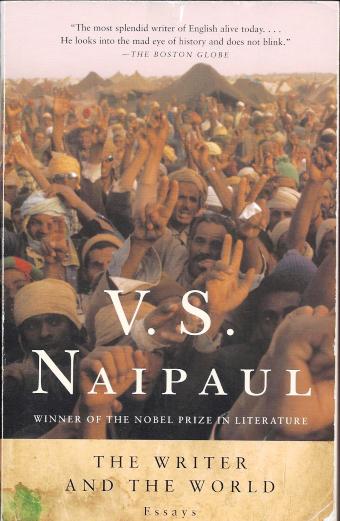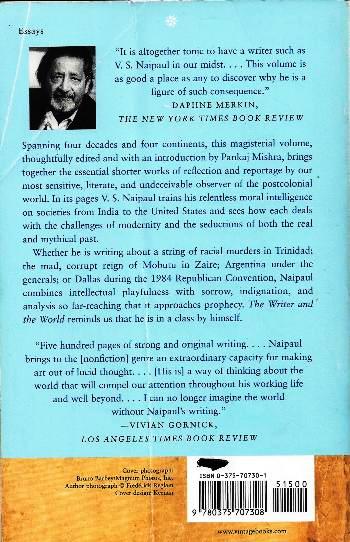 |
Vẫn chuyện
phê bình, điểm sách, do nhà văn, tiểu thuyết gia viết. GCC đọc
Mantel mới đây thôi, sau khi bà đoạt liền tù tì hai Booker Prize, hai
cuốn tiểu
thuyết,
cùng đề tài, cùng 1 dạng, tiểu thuyết lịch sử.
The New York Review of
Books In 2013, The
New York Review of Books celebrates its fiftieth anniversary. During
the course
of the year we will reprint excerpts from other notable pieces
published in the
Review over the last five decades. For news and
features about the fiftieth anniversary, visit www.nybooks.com/50.
Naipaul's
Book of the World Hilary
Mantel Hilary
Mantel has contributed over forty reviews and works of fiction to The New York Review since
1989.
The following is an extract from "Naipaul's Book of the World," a
review of V. S. Naipaul's The Writer and the World. It
appeared
in the October 24,2002, issue and may be There are
places on earth where, at certain moments in the cycle of day and
night, the
two are indistinguishable. It is impossible to know, without other
referents,
whether you are looking at dawn or dusk. And there are places at the
margins of
cities, or at the edges of the man-made sprawl of holiday islands,
where at
twilight growth and decay are indistinguishable; you can't tell, at
first
glance, whether you are looking at a building site or a ruin. Is that
earth-colored brick waiting for its glassy marble cladding, or is it
crumbling
back into the condition of soil? And that distant rumble, of traffic or
marching feet: Have the entrepreneurs arrived, or is it the barbarians?
Is it
possible that they are the same? Instances of crepuscular insight,
coupled with
the qualms of self doubt, are for the privileged but disinterested eye;
they
come more readily to the artist than to the politician or the aid
worker or the
hard-hated man driving a digger into the jungle. You have to pick your
place to
stand, and work by the light of informed intellect, before you can
judge
whether social institutions or indeed whole societies are accreting
meaning or
leaking it away. Over forty years of
traveling and writing, V. S. Naipaul has
made himself both a judge and an expert witness in the topography of
"half- made societies." Visiting India in 1962, he saw "towns
which, even while they develop, have an air of decay." Montevideo in
1973
is a "ghost city" mimicking European glories. It is populated by
statues and the figures of historical tableaux cast in bronze, but
their inscriptions,
with individual letters fallen away, are becoming indecipherable. The
shops are
empty but street vendors crowd the sidewalks. The restaurants have no
meat.
Public clocks have stopped. As colonizers pack their
bags and dream cities dissolve, the
bush is always waiting to creep back. Tenderness toward the bush is an
emotion
only the secure can feel. Only those who are free to leave them can be
sentimental about the wild places of the earth. The bush is a recurrent
conceit
in Naipaul's work. It has "its own logical life," but it is a logic
that leads nowhere, except into the self-serving thickets of
irrationality. It
is the place where the social contract breaks down; it represents not
just the physical
encroachment of nature but the proliferating undergrowth of the human
psyche. From the first, Naipaul's
sardonic and fastidious approach
distinguished him from those who write about the underdeveloped world
in eggshell
pieties. He has a sharp eye for the intellectually fraudulent, and is a
scourge
of self-delusion; he gives the underdog as bad a name as his master.
Oppression, he notices, doesn't make people saintly, it makes them
potential
killers; all victims are dangerous. On the one hand he has been accused
of contempt
for peoples of the third world; less liberal readers have embraced him
as a
sort of projection of themselves, more derogatory about developing
countries
than they would ever dare to be, his color and ethnic background
excusing him
from the obloquy they would attract if they expressed the same distaste
and
unease. * One reason
to welcome the present volume is that a gap has opened, over the years,
between
what Naipaul has written, what people think he has written, and what
they feel
he ought to have written. His asides are often more pessimistic than
the body
of his work, and his dogmatic pronouncements in interviews-"Africa has
no
future"-contrast with the subtlety of thought and expression in his
written pieces. He writes with delicacy and compassion about individual
lives,
and much of the work in this collection employs a calm perspective that
his
detractors often miss. And yet, there is no respite from the Naipaul
personality,
ferociously intelligent and permanently aggrieved. As a travel writer he
knows journeys are to be endured, not
enjoyed. They look glamorous only in retrospect. Most people's
journeys, in the
course of history, have not been voluntary. Transportation, slavery,
and forced
migration have taken more people away from their birthplace than has
the desire
for novelty. Naipaul is spiritually among them, as remote from the
tourist
mentality as he is from the mind-set of those travelers who get into
trouble
only to feel smug on getting out of it. He is at all times anxious
about his
own person- the witness, after all, must be preserved-and his faculty
of
physical disgust is highly developed. Given the chance, he heads
straight for the nearest international
hotel. He knows that the unfamiliar need not be sought, for it comes to
find
you; for the nervous man, familiarity can be destroyed by a walk into
the next
room. The real undiscovered country is other people, human beings in
all their singularity.
He lets them speak and shape his narrative for him, and his respect for
their
stories is far removed from the misanthropy with which he is sometimes
taxed. It
is true that he has a dread of the flamboyant and the willfully
eccentric:
"I recognized her as a 'character," he says, warily eyeing the
manageress when checking into the only hotel in Anguilla that has
electricity.
"Characters lie on my spirit like lead." * Fastidious
in his person as in his intellect, Naipaul is a puritan in matters of
style. It
is the sparseness of his effects, his exactness, which transfixes the
reader.
Naipaul's contempt for "fine writing" is clear. He cultivates
plainness, so that his actual words are seldom remembered by the
reader; what
lingers is their authoritative rhythm, an impression of discrimination
and scruple,
of wit and restraint. "I work with very strong emotions," he has
said, "and one's writing is a refining of those emotions." With
Naipaul,
style is substance. Each sentence pounces on its meaning, neat as a
cat. Each
paragraph has attack, dash, élan. There are no jokes, no whimsy; there
is no descent
to the demotic, no bravura display. What has been important to
Naipaul throughout his career is
to make a relationship with language that is clean, unflawed, fit for a
man who
has had to write himself into being. It is a common experience of
expatriates
and travelers that, when you meet someone from another culture, you
begin to
act out a part you feel you have been assigned in an earlier life. Your
persona
goes into action, and you deliver the lines provided by some mysterious
central
scripting unit. But there was no one to provide Naipaul with lines. He
has had
to write his own. He has represented no one but himself, spoken for no
one but
himself, and spoken in no one else's language. He seems impervious to
the influence
of systems, just as he is unaltered by changing fashions in writing.
You sense
that the curve of evolution in his own work comes from within himself
and is
something he alone fully understands. Perhaps what we will say
about Naipaul was that he was the
self-made man who didn't stop at weaving the cloth for his own garments
but
clothed his own bones in prose. We will say he was the rational man who
was
afraid to see night fall, because it falls within himself. His shining
belief
in order and progress is stained by an area of internal darkness: by a
natural apprehension-though
not a certainty-that the power of reason will be defeated. "The aim has
always
been to fill out my world picture, and the purpose comes from my
childhood: to
make me more at ease with myself." To our profit, this is the
one aim he has missed. His readers
may complain that they are trapped in an enactment of his own
psychodrama, but
the point is that it is not simply his own; we are all afraid of the
dark, and
though Naipaul is an isolate, he is not a solipsist. The narrator of
the novel
The Enigma of Arrival writes, "To see the possibility, the certainty,
of
ruin, even at the moment of creation; it was my temperament." Naipaul's
myth is that of the artist who has suffered more from his art than his
life,
more from his interpretations of reality than from reality itself. He
is the
person most haunted by what he has rejected, by the childhood he has
cast off,
by the private fear he has made into a universal condition. Wherever he
goes,
he is sailing the inland sea. +
|


